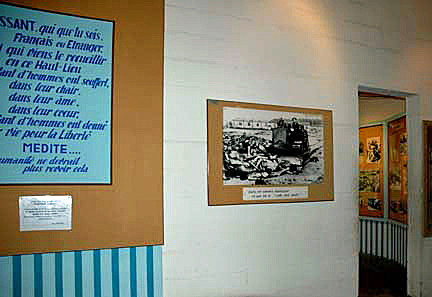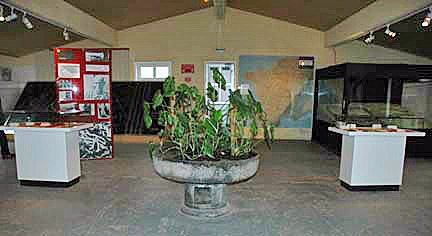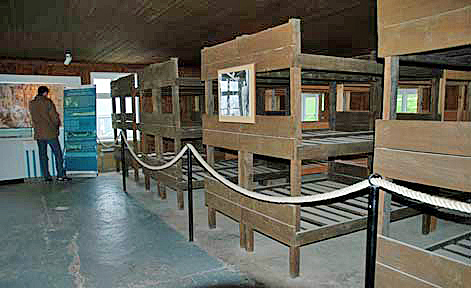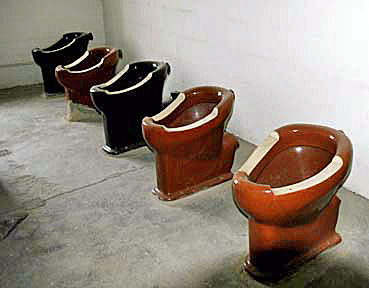Natzweiler-Struthof Museum

The photo above shows the lobby at the
entrance to the museum which is located in one of the former
barracks buildings. The picture displayed on the wall was taken
at Bergen-Belsen, an exchange camp in western Germany which became
a concentration camp in December 1944; it was voluntarily turned
over to the British on April 15, 1945 because of the typhus epidemic
there. It shows a British soldier shoving emaciated bodies into
a mass grave with a bulldozer.
On the same wall, on the left, but out
of camera range, is a dramatic photo of a survivor of Wöebbelin,
a sub-camp of Neuengamme. Apparently, there were no photos of
the Natzweiler camp, and photos of other camps are used throughout
the museum. The photos are the most gut-wrenching ones from the
Holocaust. Captions on all the exhibits are in French only.
An exhibit near the entrance says that
the original buildings in the Natzweiler camp were burned to
the ground during an arson attack in 1976, but a few of the buildings
have been reconstructed. There are displays which explain the
rise of Nazism and a huge, detailed map of the concentration
camp system. According to the displays, the Natzweiler camp was
mainly for anti-Nazi resistance fighters, including captured
British SOE agents. The medical experiments are mentioned and
there is a photo of Dr. Josef Hirt doing an autopsy. Dr. Hirt
was the one who was responsible for 87 Jews being gassed at Natzweiler
because he needed skeletons to illustrate the difference between
various races.
The photo below shows a view of the inside
of the museum. In the center is a large wash basin of the type
used in all the concentration camp washrooms. It is being used
here as a plant holder. There is another room in the museum which
shows two other washbasins just like this one. On the right in
the photo below, inside a glass case, is a model of the camp.
According to the model, there was another large section of the
camp where SS soldiers lived. On the left is a photo display,
showing pictures that I recognized from Dachau, Sachsenhausen
and Buchenwald.

The photo below shows bunk beds that
were used in the Natzweiler camp. The photo on the end of the
bed in the center was taken at Buchenwald.

The photo below shows flush toilets in
the museum, which was formerly a barrack building. The toilets
have no seat, which is the way European toilets were apparently
made back then. The toilet in the Anne Frank house in Amsterdam
has no seat and looks like the ones in this photo, except that
it is white with blue flowers.

|